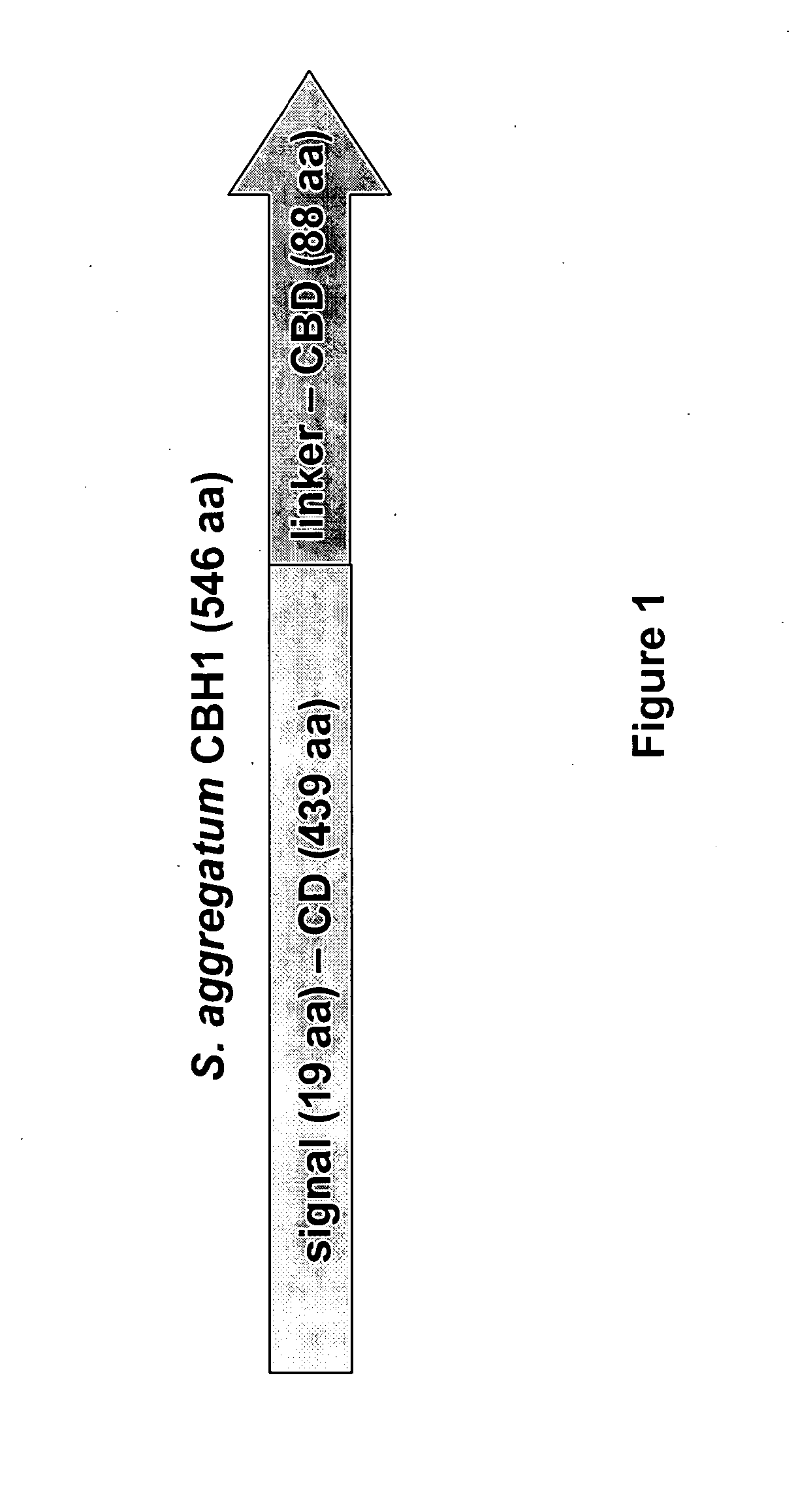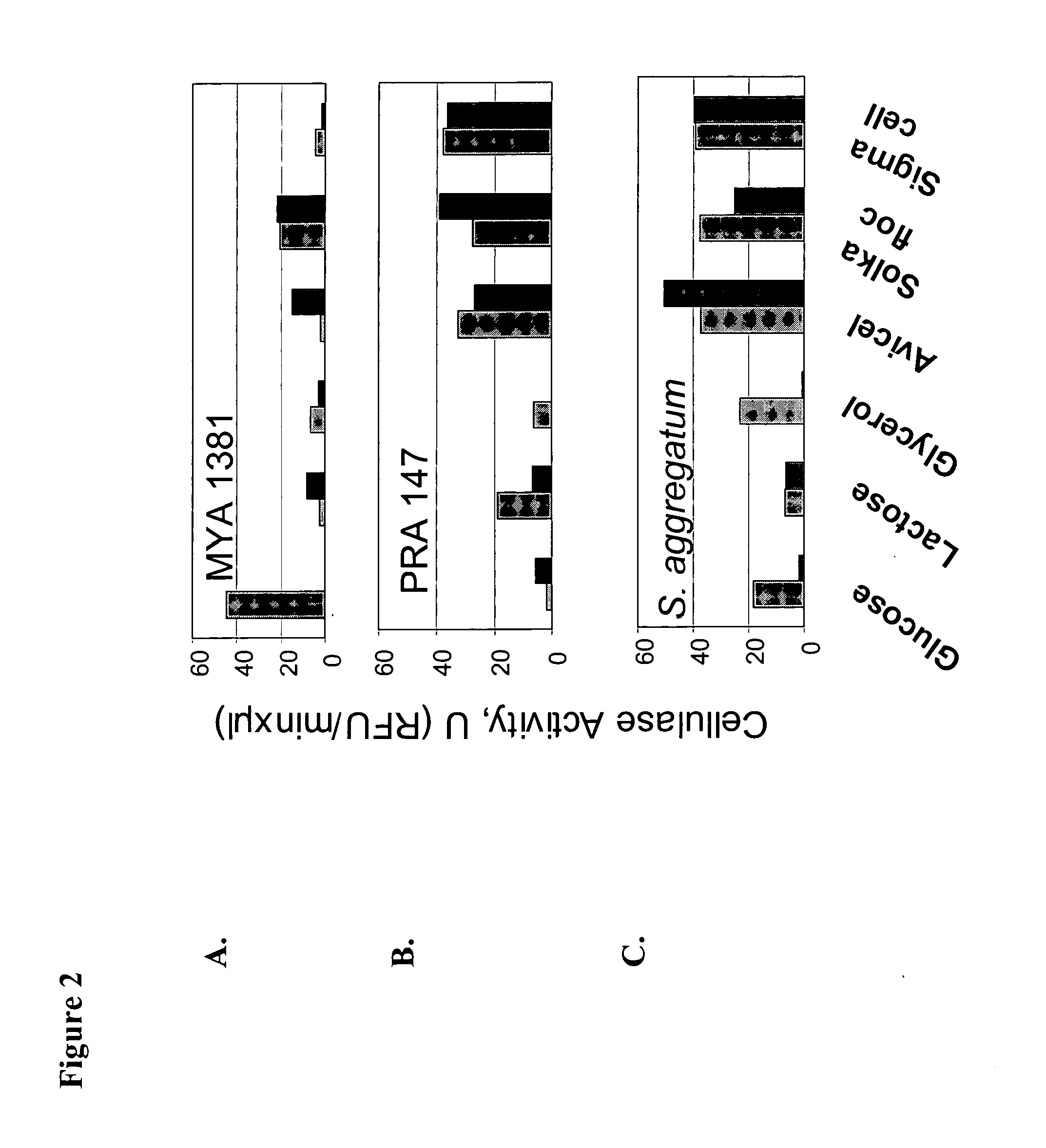Isolation and Characterization of Schizochytrium Aggregatum Cellobiohydrolase I (CBH I)
a cellobiohydrolase and schizochytrium technology, applied in biofuels, peptides, enzymology, etc., can solve the problems of inability to achieve amorphous cellulose fermentation, general absence of low-cost technology for overcoming the recalcitrance of these materials, etc., to achieve the effect of facilitating ethanol production and cellulose digestion
- Summary
- Abstract
- Description
- Claims
- Application Information
AI Technical Summary
Benefits of technology
Problems solved by technology
Method used
Image
Examples
example 1
Isolation of Schizochytrium aggregatum cbh1
[0197]The isolation of genes for saccharolytic enzymes from cellulolytic marine fungoid organisms of the Thraustochytrid family was considered. Thraustochytrids are important mangrove decomposers on decaying cellulose-rich materials such as macroalgae and mangrove leaves. Thus, Thraustochytrid family organisms are potential candidates from which novel cellulases can be isolated. Cellulase production has been detected in the Thraustochytrid family marine fungoid protist Schizochytrium aggregatum (Bremer GB, 1995). Given the production of cellulase in this organism, it was determined that isolation of a cellobiohydrolase I (cbh1) gene from Schizochytrium aggregatum would be advantageous, as the encoded protein could serve as a potential exoglucanase for use in a consolidated bioprocessing system.
[0198]Secreted and cell associated cellulase activity was measured for three cellulolytic marine fungoid Thraustochytrid strains, obtained from ATCC....
example 2
Homology and Proteomics Analysis of Schizochytrium aggregatum Cbh1
[0211]The isolated Schizochytrium aggregatum Cbh1 is novel. No identical sequences can be found in the public protein databases (PubMed). The translated sequence, based on sequence homology, belongs to the Glycosyl Hydrolase Family 7 (GHF7) of proteins and contains tunnel forming loops. Therefore, the sequence was predicted to encode a exogluconase type I or Cbh1 based on previous data demonstrating that exoglucanases have tunnel forming loops, whereas endoglucanases do not (see Zhou X et al., Gene 395:29-39 (2007). The isolated cbh1 gene is predicted to contain a N-terminal 19 amino acid signal sequence, and thus encodes a secreted protein. A schematic diagram of Schizochytrium aggregatum Cbh1 is shown in FIG. 1, depicting the presence of a catalytic domain (CD) and a cellulose binding domain (CBD).
[0212]Results of BLAST analysis between PCR products obtained from reactions using Primers #39 and 40 as described supra...
example 3
Functional Expression of Schizochytrium aggregatum Cbh1 in Saccharomyces cerevisiae
[0217]To evaluate expression and activity of the novel Schizochytrium aggregatum Cbh1, the cbh1 cDNA, with its native signal sequence, was inserted into an episomal yeast expression vector under control of the ENO1 promoter and terminator to generate the pMU506 construct. The pMU506 construct is depicted in FIG. 4.
Yeast Transformation
[0218]A lithium acetate transformation (LiOAc) protocol was utilized for transformation of yeast with episomal plasmids containing the cbh1 sequence. Yeast were grown in 2 ml YPD media at 30° C. overnight. In the morning, 50 ml of YPD were inoculated with 0.5 ml of the overnight culture. This 50 ml culture was grown at 30° C. with shaking. After 4-5 hours, the yeast cells were spun down in a clinical centrifuge at 13,200 rpm for 5 minutes. The cells were suspended in sterile water and spun again. The cells were then suspended in 1 ml 100 mL LiOAc and transferred to a mic...
PUM
| Property | Measurement | Unit |
|---|---|---|
| cell density | aaaaa | aaaaa |
| temperature | aaaaa | aaaaa |
| temperature | aaaaa | aaaaa |
Abstract
Description
Claims
Application Information
 Login to View More
Login to View More - R&D
- Intellectual Property
- Life Sciences
- Materials
- Tech Scout
- Unparalleled Data Quality
- Higher Quality Content
- 60% Fewer Hallucinations
Browse by: Latest US Patents, China's latest patents, Technical Efficacy Thesaurus, Application Domain, Technology Topic, Popular Technical Reports.
© 2025 PatSnap. All rights reserved.Legal|Privacy policy|Modern Slavery Act Transparency Statement|Sitemap|About US| Contact US: help@patsnap.com



